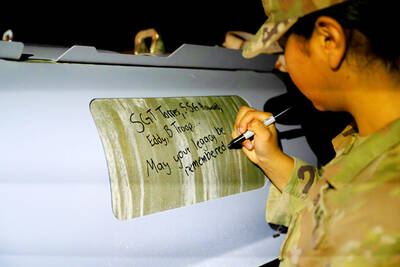The US is operating "floating prisons" to house those arrested in its war on terror, said human rights lawyers, who claim there has been an attempt to conceal the numbers and whereabouts of detainees.
Details of ships where detainees have been held and sites allegedly being used in countries across the world have been compiled as the debate over detention without trial intensifies on both sides of the Atlantic. On Sunday the US government was urged to list the names and whereabouts of all those detained.
Information about the operation of prison ships has emerged through a number of sources, including statements from the US military, the Council of Europe and related parliamentary bodies, and the testimonies of prisoners.
The analysis, due to be published this year by the human rights organization Reprieve, also claims there have been more than 200 new cases of rendition since 2006, when US President George W, Bush declared that the practice had stopped.
It is the use of ships to detain prisoners, however, that is raising fresh concern and demands for inquiries in Britain and the US.
Research carried out by Reprieve found the US may have used as many as 17 ships as “floating prisons” since 2001. Detainees are interrogated aboard the vessels and then rendered to other, often undisclosed, locations, it was claimed.
Ships that are understood to have held prisoners include the USS Bataan and USS Peleliu. A further 15 ships are suspected of having operated around the British territory of Diego Garcia in the Indian Ocean, which has been used as a military base by the UK and the Americans.
Reprieve will raise particular concerns over the activities of the USS Ashland and the time it spent off Somalia early last year conducting maritime security operations in an effort to capture al-Qaeda terrorists.
At this time many people were abducted by Somali, Kenyan and Ethiopian forces in a systematic operation involving regular interrogations by individuals believed to be members of the FBI and CIA. Ultimately more than 100 individuals were “disappeared” to prisons in locations including Kenya, Somalia, Ethiopia, Djibouti and Guantanamo Bay.
The Reprieve study includes the account of a prisoner released from Guantanamo Bay, who described a fellow inmate’s story of detention on an amphibious assault ship.
“One of my fellow prisoners in Guantanamo was at sea on an American ship with about 50 others before coming to Guantanamo ... he was in the cage next to me. He told me that there were about 50 other people on the ship. They were all closed off in the bottom of the ship. The prisoner commented to me that it was like something you see on TV. The people held on the ship were beaten even more severely than in Guantanamo,” the inmate said.
“They choose ships to try to keep their misconduct as far as possible from the prying eyes of the media and lawyers. We will eventually reunite these ghost prisoners with their legal rights, said Clive Stafford Smith, Reprieve’s legal director.
“By its own admission, the US government is currently detaining at least 26,000 people without trial in secret prisons, and information suggests up to 80,000 have been ‘through the system’ since 2001. The US government must show a commitment to rights and basic humanity by immediately revealing who these people are, where they are, and what has been done to them,” Stafford Smith said
Conservative Member of Parliament (MP) Andrew Tyrie, who chairs the parliament’s all-party group on extraordinary rendition, called for the US and UK governments to come clean over the holding of detainees.
A US Navy spokesman, Commander Jeffrey Gordon, said: “There are no detention facilities on US navy ships.”
However, he added that it was a matter of public record that some individuals had been put on ships “for a few days” during what he called the initial days of detention. He declined to comment on reports that US naval vessels stationed in or near Diego Garcia had been used as “prison ships.”

REVENGE: Trump said he had the support of the Syrian government for the strikes, which took place in response to an Islamic State attack on US soldiers last week The US launched large-scale airstrikes on more than 70 targets across Syria, the Pentagon said on Friday, fulfilling US President Donald Trump’s vow to strike back after the killing of two US soldiers. “This is not the beginning of a war — it is a declaration of vengeance,” US Secretary of Defense Pete Hegseth wrote on social media. “Today, we hunted and we killed our enemies. Lots of them. And we will continue.” The US Central Command said that fighter jets, attack helicopters and artillery targeted ISIS infrastructure and weapon sites. “All terrorists who are evil enough to attack Americans are hereby warned

Seven wild Asiatic elephants were killed and a calf was injured when a high-speed passenger train collided with a herd crossing the tracks in India’s northeastern state of Assam early yesterday, local authorities said. The train driver spotted the herd of about 100 elephants and used the emergency brakes, but the train still hit some of the animals, Indian Railways spokesman Kapinjal Kishore Sharma told reporters. Five train coaches and the engine derailed following the impact, but there were no human casualties, Sharma said. Veterinarians carried out autopsies on the dead elephants, which were to be buried later in the day. The accident site

RUSHED: The US pushed for the October deal to be ready for a ceremony with Trump, but sometimes it takes time to create an agreement that can hold, a Thai official said Defense officials from Thailand and Cambodia are to meet tomorrow to discuss the possibility of resuming a ceasefire between the two countries, Thailand’s top diplomat said yesterday, as border fighting entered a third week. A ceasefire agreement in October was rushed to ensure it could be witnessed by US President Donald Trump and lacked sufficient details to ensure the deal to end the armed conflict would hold, Thai Minister of Foreign Affairs Sihasak Phuangketkeow said after an ASEAN foreign ministers’ meeting in Kuala Lumpur. The two countries agreed to hold talks using their General Border Committee, an established bilateral mechanism, with Thailand

‘POLITICAL LOYALTY’: The move breaks with decades of precedent among US administrations, which have tended to leave career ambassadors in their posts US President Donald Trump’s administration has ordered dozens of US ambassadors to step down, people familiar with the matter said, a precedent-breaking recall that would leave embassies abroad without US Senate-confirmed leadership. The envoys, career diplomats who were almost all named to their jobs under former US president Joe Biden, were told over the phone in the past few days they needed to depart in the next few weeks, the people said. They would not be fired, but finding new roles would be a challenge given that many are far along in their careers and opportunities for senior diplomats can